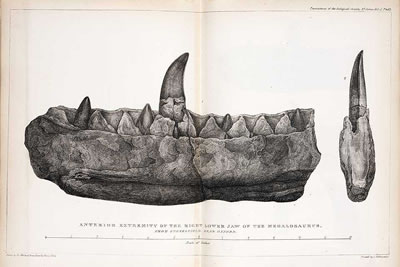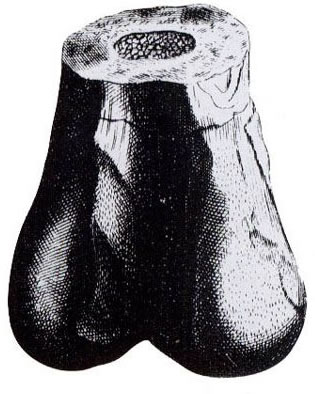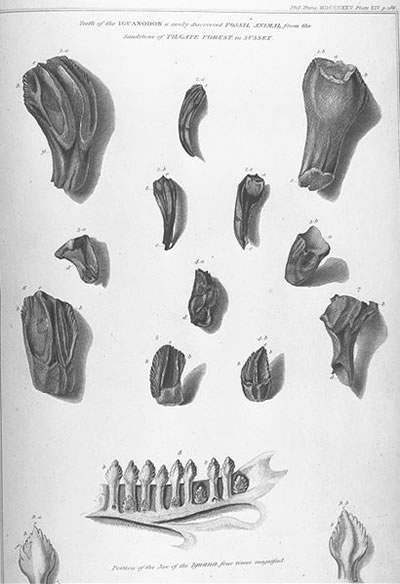Human beings probably have been discovering dinosaur fossils for thousands of years. However, for most of this time, people did not realize what they were.
For a long time, many people thought that the Earth was only a few thousands of years old. Therefore, they often assumed that the dinosaur bones that they found were from mythical creatures such as dragons or giants.
People also did not realize that whole groups of animals could die out (become extinct).
The concept of extinction, as we know it today, was first presented by the French naturalist Georges Cuvier in a paper that he published in 1796.
 The first dinosaur to be named formally was Megalosaurus.
The first dinosaur to be named formally was Megalosaurus.
In 1824, William Buckland, Professor of Geology at Oxford University, published a description of some bones - a jawbone, ribs, vertebrae and some limb bones - that had been found in a quarry not far from the university. Buckland named the creature to whom these bones once belonged "Megalosaurus", or "giant lizard."
Although they were the first Megalosaurus bones to be named, they were not the first to have been found.
 In the 17th century, a fragment of a thigh bone that had been found in a quarry near Oxford was sent to Robert Plot, who was then Professor of Chemistry at Oxford University. In 1676, Plot described this bone in his book, "The Natural History of Oxfordshire." The description included an illustration.
In the 17th century, a fragment of a thigh bone that had been found in a quarry near Oxford was sent to Robert Plot, who was then Professor of Chemistry at Oxford University. In 1676, Plot described this bone in his book, "The Natural History of Oxfordshire." The description included an illustration.
Plot realized that the bone was too big to belong to any animal species that was known at the time.
He concluded that it was the thigh bone of a giant.
However, the illustration shows that it was, in fact, a bone from Megalosaurus.
The next dinosaur to be named was Iguanodon.
 Mary Ann Mantell, wife of the British paleontologist Gideon Mantell, found a gigantic tooth in a pile of rubble in Sussex, England in 1822. She showed the tooth to her husband. He found some more bones from the same animal close to where his wife had found the tooth
Mary Ann Mantell, wife of the British paleontologist Gideon Mantell, found a gigantic tooth in a pile of rubble in Sussex, England in 1822. She showed the tooth to her husband. He found some more bones from the same animal close to where his wife had found the tooth
Thinking that this animal was a giant lizard, in 1825, he named it "Iguanodon" which means "Iguana tooth."
The word Dinosaur was invented by the Richard Owen, a British paleontologist, in 1842. By that time, specimens from five or six creatures similar to Iguanodon and Megalosaurus had been found.
Owen realized that these were not huge lizards; they were a completely different type of creature that had never been studied before. He gave them the name "Dinosaur" - powerful or terrible lizard.
Early Dinosaur Hunters
Andrew Carnegie, an American millionaire, spent 25 million dollars on expeditions to collect dinosaur fossils between 1895 and 1905.
In 1899, during one of these expeditions, a complete Diplodocus skeleton was found. Carnegie had life-size casts made of it. These were sent to museums around the word. It became known as the species Diplodocus carnegii.
Earl Douglass, a paleontologist working for Carnegie, found many dinosaur skeletons deposited together in a site near the border of Utah and Colorado. In 1915, this site became a national monument known as Dinosaur National Monument.
Werner Janensch, a German geologist led a fossil collecting expedition in German East Africa (now Tanzania) that began in 1907. 250 tons of dinosaur bones, which included some complete Brachiosaurus skeletons, were found during this expedition.
Between 1900 and 1920, two teams led by Barnum Brown and Charles Sternberg collected hundreds of dinosaur specimens in North America.